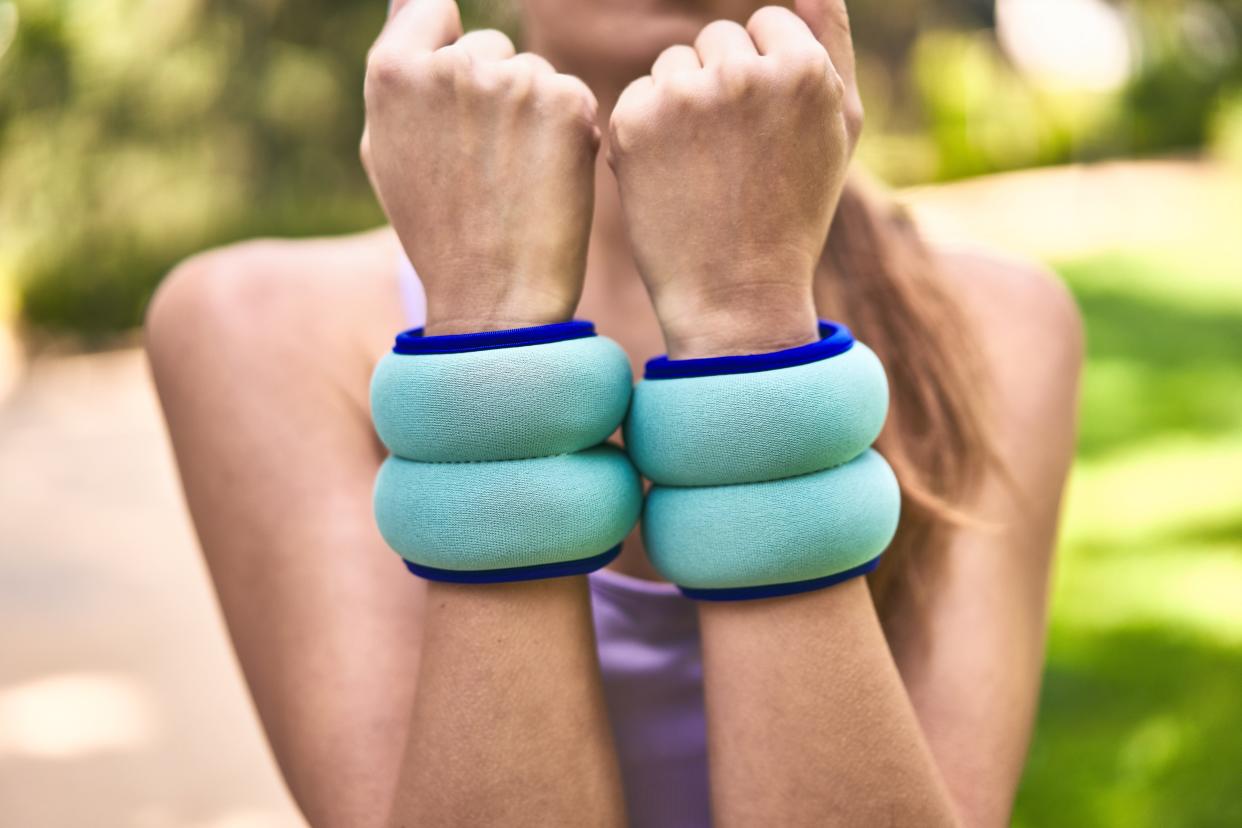Does Adding Wrist Weights to Your Walk Really Give You a Better Workout?

Asier/Adobe Stock
Remember back in the ’90s when neighborhood moms would power walk around the streets with weights strapped on their wrists? Well, this retro fitness fad is back, and maybe even trendier this time around. All over TikTok, people are using wrist weights to build muscle in their arms and get max benefits out of their walks.
But is strapping on wrist weights actually an effective workout strategy? Here’s what you should know if you’re tempted to add some bangles to your step count.
Walking with wrist weights definitely makes you work harder–maybe not in the way you think, though.
Strapping weights to your wrists adds a little extra load on your body, increasing the challenge of each step. That added work affects not only your muscles and joints, but also your heart, which starts to pump faster. This extra effort “strengthens your cardiac muscle,” Teddy Savage, CPT, national lead fitness trainer at Planet Fitness, tells SELF. So with wrist weights, your daily walk can become an even more effective workout, without requiring you to pick up the pace.
It supercharges your routine in a few ways: One 2021 study on college students published in the Federation of American Societies for Experimental Biology (FASEB) Journal found that their heart rates and oxygen consumption—a marker of exercise intensity or how much energy you’re expending—were higher when they wore wrist weights while walking. Other research found that when folks wore both wrist and ankle weights during daily activities for just 20 minutes three times a week, it increased their amount of muscle.
However, because the load from wrist weights is so light, the muscle-building effects will be pretty minimal. “I wouldn’t think about this as adding a lot of strength or growth to your muscles,” Savage says. “It’s not going to do that.”
That’s because muscle growth happens when exercise creates microscopic tears in your muscle fibers, which your body then repairs. There has to be enough stress to your muscles to cause those tears, and in many cases, a weight that feels really light to you isn’t going to do it.
If you really want to build stronger biceps, triceps, and shoulders, challenging those muscles with heavier weights is going to be key, Kelly Bernadyn, CPT, a Michigan-based group fitness instructor at Life Time clubs, tells SELF. (Important note: “Heavy” is pretty subjective, and there’s no set definition—it basically means whatever is “heavy” to you. Bernadyn defines it as a weight you can only lift about six times or so before your form starts getting sketchy.) In particular, Savage suggests following a progressive overload plan, where you gradually increase the challenge over time by lifting heavier, adding reps, or decreasing your rest breaks to make the exercise harder so that your muscles keep responding.
What to know before adding wrist weights to your walks:
Knowing that this trend will give you a cardio boost more than anything, here’s what to keep in mind if you want to give it a shot. First off, if you have elbow or shoulder injuries or balance issues, you might want to sit this one out to stay safe, Bernadyn says. And Savage suggests anyone with bone density issues check in with their doctor first. But if you’ve got the all-clear, just watch that the weights aren’t messing with your walking form, and then follow these trainer tips.
Start gradually.
When you first add wrist weights to your walk, Bernadyn suggests sticking with one to three pounds. You can maybe graduate up to five pounds once your body gets used to the challenge. But any more than that could put too much tension on your elbow joint. “Ease into it, because you don’t want to get tennis elbow by adding an extra load to a joint that’s not used to it,” she says. Savage also suggests cutting back your mileage at first until your body adapts to having some additional weight on your arms. So if you normally walk for three miles, you might want to start with one and a half when you add the weights
Relocate the weight for a bigger cardio challenge.
To up the cardio intensity of your walk even more, you may want to consider rucking, where the extra pounds are on your trunk, either in a backpack or weighted vest. You can add far more weight because it’s sitting on your center of gravity rather than the ends of your limbs, Savage points out. Of course, this setup won’t work your biceps or triceps, but it will get your heart pumping faster.
Don’t forget your other workouts.
If you think adding some fitness-y jewelry to your walks will be your golden ticket to stronger arms, you’re probably going to end up frustrated. That’s where upper-body strength training (and we have a whole bunch of those workouts to choose from right here) comes in clutch. Still, that doesn’t mean your bangles can’t give your overall wellness routine a little boost. “This is just another crayon in the box of 64, right?” Savage says. “We want to create the most colorful and robust picture of wellness we possibly can. So adding something new is wonderful.”
Related:
Originally Appeared on SELF


